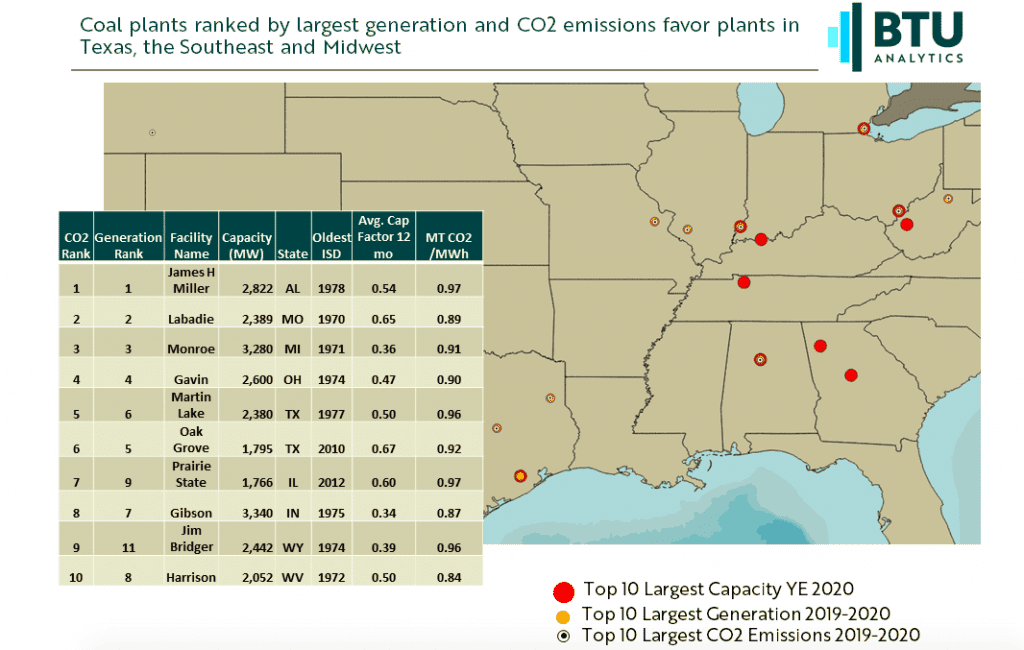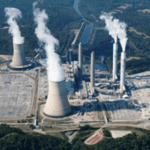A report from a Colorado-based group that provides analysis and market reports to the energy industry says an Alabama power plant has the highest emissions of carbon dioxide (CO2) of any coal-fired facility in the Lower 48 states.
BTU Analytics in a report released April 29 ranked the James H. Miller plant in West Jefferson, Alabama, about 20 miles northwest of Birmingham, as the largest CO2 emitter. The plant has four coal-fired units, the first of which came online in 1978, with Unit 4 entering operation in 1991.
The report, which lists the 10 U.S. plants (Figure 1) with the highest level of CO2 emissions, comes as many groups, including the U.S. Dept. of Energy (DOE), look at ways to support technologies designed to make coal plants more efficient and to reduce their emissions of pollutants. The DOE on April 23 announced $75 million in funding to engineer carbon capture projects; the DOE’s Loan Programs Office (LPO) also said it has $8.5 billion in funding for carbon capture projects through LPO’s Title 17 Innovative Energy Loan Guarantee Program.

The DOE last year announced that the agency’s Office of Fossil Energy chose four projects “for cost-shared research and development” as part of its Coal FIRST initiative, and said it estimated that about $80 million in federal funding would be provided to those projects. The agency has said it is focused on seven areas of interest for cleaner coal technology, including several supercritical CO2 power plant systems.
Many groups, including The Sierra Club and others, have said that federal money should be directed toward clean energy resources, although energy industry analysts have said they expect U.S. coal units will continue to operate for many years. Some analysts say the need for baseload power, particularly as more intermittent renewable energy is added to the grid, means coal and other thermal plants must remain part of the U.S. generation mix.
Jonathan Levenshaus, Sierra Club’s Director of Federal Campaigns, told POWER that “Spending any more money on coal plants is a massive risk. It ignores where the market and people are going on coal and fossil fuels overall. That money would be better spent investing in rapidly building clean energy as well as supporting coal workers and communities as the country transitions from fossil fuels.”
The DOE on April 23 announced it will provide $109.5 million in funding for projects that directly support job creation in communities impacted by the move away from fossil fuels, particularly for workers and areas struggling due to closures of coal-fired power plants and coal mines. The White House Interagency Working Group said it also had identified about $38 billion in existing federal funding “that could be accessed by energy communities for infrastructure, environmental remediation, union job creation, community revitalization, and jobs well-suited to support hard-hit energy communities.”
Utility Touts Miller Plant’s Generation
The Miller plant (Figure 2), operated by Alabama Power, which is part of Southern Co., has been tabbed as the largest emitter of greenhouse gases in the U.S. by other organizations in recent years, including the U.S. Environmental Protection Agency (EPA) and The Weather Channel. EPA data shows the plant has been among the top three greenhouse gas-producing U.S. facilities—the data includes power plants and other industrial operations—since the federal government began tracking such levels more than a decade ago.
The Environmental Integrity Project earlier this year cited the plant in a report on greenhouse gas (GHG) emissions from power plants, though it noted that GHG emissions from U.S. facilities fell 38% from 2005 to 2020. The group’s report, based on EPA data, also said Alabama alone saw its emissions decline 46% during that period.

Alabama Power spokesperson Alyson Tucker in an email to POWER said, “Plant Miller is an efficient generating facility, producing more electricity than any other coal plant in the nation. We have achieved significant GHG reductions—more than 40% across our generation fleet from 2007-2020—and expect emissions to be further reduced over time. At Plant Miller, we have implemented state of the art technology for emission reduction, including scrubbers and SCRs [selective catalytic reduction units].”
EPA data shows that the Miller plant, which Alabama Power says has a nameplate capacity of 2,640 MW, has reduced its emissions by more than half over the past several years, after the utility installed those pollution controls to comply with federal regulations.
Coal Plants Ranked
BTU ranked coal-fired plants in the Lower 48 states based on their generation capacity, capacity factors, and emissions intensity per megawatt hour of electricity produced.
Andrew Bradford, CEO of BTU Analytics and the author of the report, told POWER his group in its user interface “is tying together all these data sets, generation queues, EIA [Energy Information Administration] data. We’ve done a bunch of work on EPA CEMS [continuous emissions monitors] data. We’ve had generation and heat rate in our user interface, and basically now for all [U.S.] thermal plants you can look at heat rate, generation, and heat input. We’ve added data on CO2, NOx [oxides of nitrogen] and SOx [sulfur oxide] for every plant.”
Bradford in the report said that his group looked at coal plant CO2 emissions and plant generation, and said “the linear relationship is clearly showing that coal generation emits in a pretty tight range of about 1 metric ton of CO2 per MW generated.” He said when looking at the top 10 CO2 emitting coal plants as a group, “they emit as much as the top 57 natural gas plants while these gas plants generated 15 times the amount of generation in 2019-2020.”
294 Coal Plants Still Operating
BTU in its report said 294 coal plants remain in service in the Lower 48, representing 234 GW of generation capacity, with 69 GW of that total having publicly announced retirement dates through year-end 2030. The group said the 10 plants that emit the most CO2 represent 16% of all coal plant emissions from those 294 plants. The group’s data set includes includes CO2, NOx and SOx emissions going back to 2010.
The group’s analysis also looks at how the market for different types of power generation, including renewables, is changing in the regions around those top-emitting plants. Those 10 plants are sited in eight different states, including two in Texas.
“What’s really interesting is just to look at where the biggest emitters are,” said Bradford, pointing to plants in the southeastern U.S. “You see where those plants are located, and then you see where solar power projects are being sited. Solar, in areas like Georgia and Alabama, is going to grow, and if you believe everything in our vetted view [of data], it gets to be a pretty big number,” in terms of renewable energy that could potentially replace coal-fired generation.
Several Factors Analyzed
Bradford said generation and CO2 emissions in BTU’s analysis were calculated for the 2019-2020 period using EPA CEMS data contained in BTU Analytics’ Power View platform. The group noted that the Miller plant, while not having the largest generation capacity among the top emitters, has a combination of “a relatively high plant capacity, a higher-than-average capacity factor, and a high emissions intensity of 0.97 MT CO2/MWh,” which elevates its emissions level.
The report notes that there is “logically a close correlation between a coal plant’s CO2 ranking and generation ranking,” with three plants ranking in the top 10 in each of those categories—Miller in Alabama; the James M. Gavin Power Plant in Cheshire, Ohio; and the Gibson Generating Station in Gibson County, Indiana. BTU also said that five of the largest coal plants, as measured by plant capacity at the end of last year, are not among the top 10 emitters because they have lower capacity utilization levels. Those plants include the 3,600-MW Plant Scherer in Juliette, Georgia; the 3,499-MW Plant Bowen near Euharlee, Georgia; the 2,933-MW John E. Amos plant in Winfield, West Virginia; the 2,600-MW Cumberland Fossil Plant in Cumberland City, Tennessee; and the 2,600-MW Rockport Plant in Rockport, Indiana.
Some Units Being Retired
Some or all of the units at those plants are scheduled for retirement. Unit 4 at Plant Scherer is set to close no later than Jan. 1, 2022, at which point Scherer will no longer be the largest U.S. coal-fired plant, ceding that title to Plant Bowen. Plant Scherer, where the first coal-fired unit began operating in 1982, has a storied history among U.S. coal plants, and in 2017 was named the Powder River Basin Coal Users’ Group Plant of the Year.
“The only thing that’s going to take the [emissions] number down is some sort of carbon capture,” said Bradford. “The biggest plants by capacity, like Scherer and Bowen, are feeling pressure on the economic side.”
A late 2020 report from the Institute for Energy Economics and Financial Analysis said Plant Bowen is likely to shut down as Georgia Power, like many U.S. utilities, continues to move away from coal-fired generation as it produces more electricity from renewable resources. Georgia Power also expects to have the two new reactors at its Plant Vogtle nuclear plant operating within the next two years, which also could lead to a phase-out of the utility’s coal units.
Appalachian Power, a subsidiary of American Electric Power (AEP), already is looking at the impact on customers of taking the Amos plant offline. In addition, AEP on April 22 announced it would close both 1,300-MW units at Rockport by year-end 2028.
The Gavin plant has its own history. The plant along the Ohio River today is owned by Lightstone Generation, a joint venture of The Blackstone Group hedge fund and private equity firm ArcLight Capital Partners, which bought the plant from AEP in a $2.2-billion deal in 2016. AEP in 2002, facing lawsuits related to air pollution in the area, bought out the town’s residents, reportedly paying them 3.5 times the value of their homes to leave. Reports said that deal cost AEP $20 million.
The Gibson plant in Indiana is largest in Duke Energy’s fleet. It was commissioned by then-Public Service Indiana in 1976. It at various times in the past decade has been referred to as the nation’s largest coal-fired plant, owing to generation reductions at some of the country’s other large coal plants in the past decade. The Gibson plant has undergone several upgrades to reduce emissions, including SCR technology on all five of its units, as well as with retrofits to install wet flue gas desulfurization systems.
—Darrell Proctor is associate editor for POWER (@POWERmagazine).










